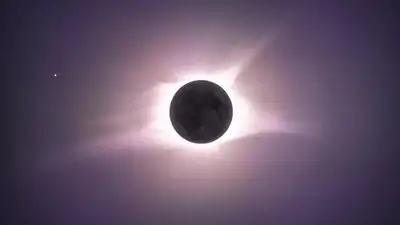ARTICLE AD BOX

A total lunar eclipse, or 'Blood Moon,' will grace the skies on September 7, 2025, visible across India. In Hindu tradition, this Chandra Grahan brings the observance of Sutak Kaal, a period of spiritual caution beginning nine hours before the eclipse.
Chandra Grahan, or lunar eclipse, occurs when the Earth comes directly between the Sun and the Moon, causing Earth’s shadow to fall on the lunar surface. This celestial alignment usually happens during the full moon phase.
At times, the Moon appears darkened or takes on a reddish hue, popularly called the “Blood Moon.” While science explains it as a natural phenomenon of light and shadow, in Hindu tradition and Vedic astrology, Chandra Grahan is seen as a spiritually charged event with significant impact on human life, rituals, and cosmic energies.The Chandra Grahan 2025 will be seen in the skies on 7 September, bringing with it both astronomical wonder and deep spiritual significance.
Known as a “Blood Moon”, this total lunar eclipse will be clearly visible in India and across several parts of the world.
What is Sutak Kaal?
As per popular beliefs, in Hindu tradition, Sutak Kaal refers to a spiritually inauspicious time observed before and during a lunar or solar eclipse. It is believed that during this period, the cosmic energies are disturbed, and the environment becomes spiritually and psychologically “contaminated.”
For Chandra Grahan on September 7, 2025, Sutak Kaal begins approximately 9 hours before the eclipse around 12:57 PM IST, and continues until the eclipse concludes, i.e., about 1:26 AM on September 8.
Why is Sutak observed?
As per traditional beliefs, there are spiritual and cultural reasons for observing Sutak Kaal:Purity and preparation: Sutak is considered a time to withdraw from worldly tasks and devote oneself to meditation, chanting, and prayer.Safeguarding energy: Energies are believed to be unstable, so rules about purity of food, behaviour, and thought are emphasised.Ancestor connection: This year’s eclipse coincides with Pitru Paksha, a period dedicated to honouring ancestors. Hence, Shraddha rituals and offerings are to be performed only after Sutak ends.
Prohibited activities during Sutak Kaal
Food and cooking: Cooking and eating fresh meals are avoided. Stored food should be protected with Tulsi leaves or Kusha grass.Auspicious ceremonies: Weddings, pujas, and havans are not performed during this time.Travel: Journeys are discouraged; if unavoidable, divine invocation is recommended.Temple practices: Temples remain closed, and idols are not touched.Also, expectant mothers are advised to stay indoors, avoid sharp objects, and maintain calm for protection.
Why are things prohibited during Sutak Kaal?

Credits: Canva
During Sutak Kaal of a Chandra Grahan, some of the restrictions are adhered, as this time is regarded as spiritually inauspicious and also astrologically sensitive.
According to Hindu texts, the air around the planet is made unclean during the time of an eclipse because of disrupted astronomical energies of the shadowing planets, Rahu and Ketu. In order to remain pure, individuals do not cook, eat, or engage in any kind of auspicious rituals but instead devote their time to meditation, mantra chanting and prayer.
There is no eating of food because food is regarded to take in bad vibrations and in the old days, there were no means of food preservation and cooked food would just go bad.
Tulsi leaves or Kusha grass were the things used to provide protection to grains and pickles owing to its purifying and antibacterial properties.Although contemporary science treats eclipses as an astronomical phenomenon, the Sutak restrictions are observed to minimize worldly distractions, protect spiritual energy, and encourage inner focus. Essentially, these rituals assist believers to transform what may be a turbulent phase of existence into a purification, prayer and self-development experience.
The science behind Chandra Grahan

Credits: Canva
Scientifically, lunar eclipse is a mere coincidence of the heavenly bodies, whereby the earth intercepts the sunshine and shifts it onto the Moon. The Red Moon, or reddish effect, is a phenomenon found within the atmosphere of the earth that reflects sunlight straight into the surface of the moon narrowing out the red rays.However, in spiritual practices it is perceived as an increase of energy in nature, so it is necessary to be aware and very disciplined. Chandra Grahan 2025 is not only a visual event but a very spiritual event in several cultures. Through the observation of Sutak Kaal and the practices that accompany it, the followers associate themselves with the ancient wisdom of focusing on purity, protection and spiritual development. Being on the first day of Pitru Paksha, this eclipse is even more important, as it is the only possibility to find blessings, get ancestors closer and experience not only the grandeur of this cosmic event, but also the spiritual depth of this cosmic spectacle.



.png)
.png)
.png)
















 5 days ago
4
5 days ago
4








 English (US) ·
English (US) ·